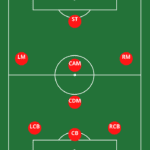- Last Updated -
Soccer Law #16, The Goal Kick… Let’s get started!
What is a goal kick in soccer? Soccer is governed by a set of rules known as the Laws of the Game. These laws provide structure and fairness to the sport, ensuring that matches unfold with integrity and adherence to a shared code of conduct.
Every aspect of play is meticulously outlined in these laws, from how goals are scored to the punishment for fouls committed on the field. In this comprehensive article, we will delve into one specific law: Law 16 – The Goal Kick.
A goal kick serves as a crucial component in restarting play from the goal area after an attacking team fails to score or sends the ball out of bounds over their opponents’ end line. Understanding this rule is vital not only for players but also for coaches, referees, and avid spectators who seek a deeper comprehension of soccer’s intricacies.
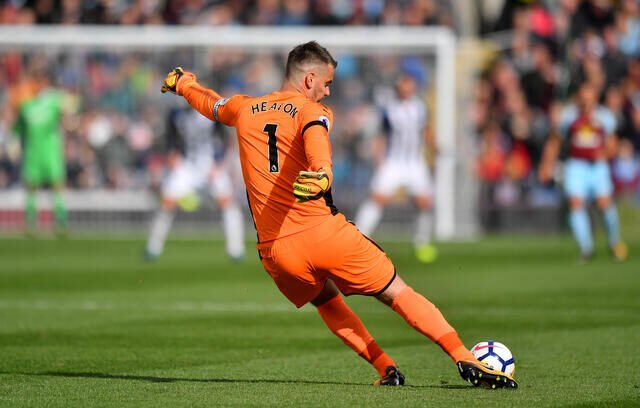
An Insight into Soccer’s Laws
Before delving into Law 16 specifically, it is essential to gain an overarching understanding of soccer’s Laws of the Game. These laws serve as a framework for fair play and define everything from player equipment regulations to what constitutes an offside offense.
Developed by The International Football Association Board (IFAB), these laws have been refined over decades to create consistency and maintain soccer’s spirit across different tournaments and competitions globally.
The Laws of the Game encompass seventeen distinct rules that outline boundaries for both players and officials alike. From defining pitch dimensions to outlining penalty kick procedures, each law contributes towards maintaining order on the field while fostering an environment conducive to skillful play and sportsmanship.
Introduction to Law 16 – The Goal Kick
Focused solely on restarts in play occurring within a team’s goal area after a failed opponent attack or out-of-bounds clearance over their end line, Law 16 – The Goal Kick is a critical aspect of soccer’s rules.
The goal kick offers the defending team an opportunity to regain control and reorganize their play by restarting from their own six-yard box. Law 16 outlines the positioning of the ball and players during this restart, ensuring fairness and proper adherence to specific rules.
As we delve deeper into this law, we will explore the purpose of the goal kick, the key elements involved in executing it correctly, and both attacking and defending players’ roles within this context. Understanding Law 16 will not only enhance your comprehension of soccer but also provide insightful knowledge into one of its fundamental aspects.

The Purpose of a Goal Kick in Soccer
Driving the Game Forward: The Necessity of Goal Kicks in Soccer
In the exhilarating world of soccer, where every second counts and strategies are honed to perfection, goal kicks serve a vital purpose in maintaining the flow and balance of the game.
A goal kick is awarded when the ball wholly crosses over the end line but was last touched by an attacking player. This ruling ensures fairness by giving possession back to the defending team, allowing them to restart play from their six-yard box.
Such a restart is crucial as it allows teams to regain composure, reposition players strategically, and launch counterattacks or build up play methodically. When a goal kick takes place, it signifies a momentary pause in an intense battle between two teams.
It creates an avenue for resetting and reshaping tactical plans for both sides. The defending team gains respite from potential attacking threats while having full control over how they want to rebuild from their goalkeeper’s distribution.
On the other hand, for the attacking team, it presents a moment of anticipation as they aim to pressure their opponents immediately upon receiving possession again. Thus, goal kicks inject multiple dimensions into a game that thrives on strategic thinking and swift decision-making.
Resuming Play with Finesse: The Significance of Restarting from the Goal Area
Restarting play from within one’s goal area holds immense significance in soccer due to its impact on shaping both defensive and offensive strategies during a match.
It allows teams to regain control from potentially dangerous situations near their net while providing opportunities for organized build-up play that can unlock opposing defenses. From a defensive standpoint, restarting play with a goal kick enables teams to disperse opponents who were likely crowding around their penalty area during an attacking phase.
It allows defenders not only time but also space to distribute the ball accurately. This can open up avenues for quick counterattacks or initiate a patient build-up play from the back, with defenders pushing forward and midfielders finding pockets of space to receive the ball.
On the offensive end, goal kicks present an opportunity for teams to switch from a reactive to a proactive approach. By placing players in strategic positions across the pitch, they can create passing triangles that aid in fluid ball circulation.
Moreover, it allows for more controlled possession and precision passing as teams aim to move forward cohesively and penetrate their opponents’ defense. Overall, goal kicks play a crucial role in soccer by providing an essential reset button for both teams.
They not only allow defenders to relieve pressure but also enable attacking sides to regroup strategically and forge their path toward scoring goals.
The significance of restarting play from the goal area cannot be underestimated, as it influences the dynamics of a match and adds layers of excitement that keep fans on their toes throughout the game.
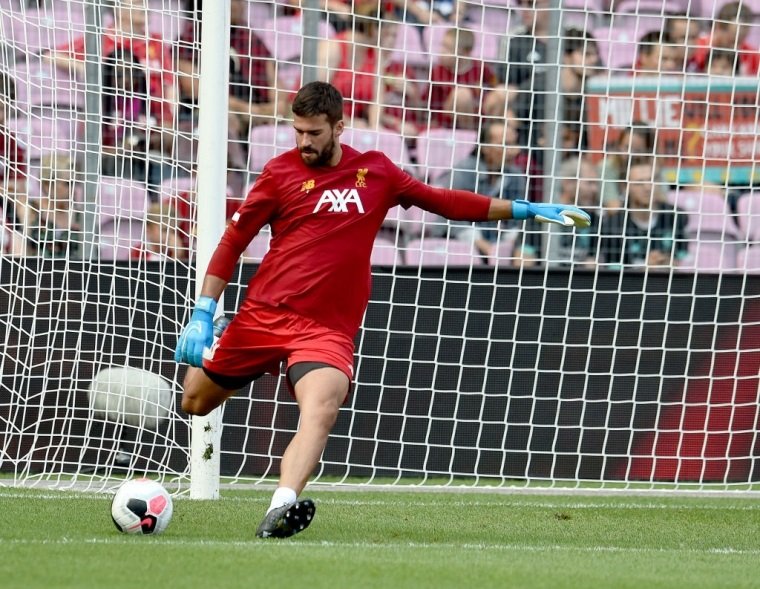
Key Elements of a Goal Kick
Location and Positioning of the Ball within the Goal Area
One essential aspect of executing a goal kick correctly is ensuring that the ball is placed within the designated six-yard box in the goal area. According to Law 16, the ball must be stationary within this specific area before it can be put into play. This requirement serves multiple purposes.
Firstly, it allows for a fair and consistent restart of play, providing both teams with an equal opportunity to compete for possession. Secondly, by positioning the ball within the six-yard box, it ensures that any attacking players looking to challenge for possession have sufficient distance from the defending team’s goal.
A Properly Positioned Ball: Stationary and Ready for Action
The stationary position of the ball during a goal kick is crucial as it sets up the conditions for an uninterrupted restart. By emphasizing its stillness, players are prohibited from rolling or dribbling it before initiating play.
This restriction ensures that no unfair advantage is gained and that all subsequent actions can be monitored effectively by match officials. Consequently, this ensures that every goal kick adheres to consistent standards across various soccer matches.
The Importance of Player Positioning During a Goal Kick
While attention is often focused on the goalkeeper during a goal kick, positioning plays an integral part for both teams involved.
Defensively, outfield players must take up strategic positions around their respective penalty area while obeying specific restrictions imposed by Law 16. These positions aim to create defensive coverage against potential attacking threats while also allowing quick counterattacks when possession is regained.
Defending Team’s Positioning and Restrictions during a Goal Kick
During a goal kick, opposing players are subject to certain rules regarding their positioning in proximity to both the kicker and goal area lines.
According to these regulations outlined in Law 16, the attacking team’s opponents must remain outside the penalty area until the ball is in play. This restriction prevents any early attempts at regaining possession by entering the penalty area prematurely.
Restrictions on Opposing Players: Patience Before Infiltration
These limitations placed on opposing players are vital for maintaining fairness and balance during a goal kick.
By disallowing their entry into the penalty area, it ensures that the defending team has a reasonable opportunity to restart play without undue pressure or interference from opposition players. Furthermore, it provides clarity to match officials who can easily identify any infringements of these restrictions and take appropriate action.
Proper Alignment: Strategic Defensive Formation
Strategic positioning of opposing players during a goal kick is crucial for maintaining defensive organization while maximally utilizing potential counterattacking opportunities.
By carefully aligning themselves outside the penalty area but close enough to be able to challenge for loose balls or apply pressure once the ball is in play, defenders can quickly regain control and initiate attacking moves.
Thus, understanding both the location and positioning of the ball within the goal area during a goal kick, as well as recognizing how opposing players should position themselves with restrictions taken into account, allows for an efficient restart of play while ensuring fair competition between teams.
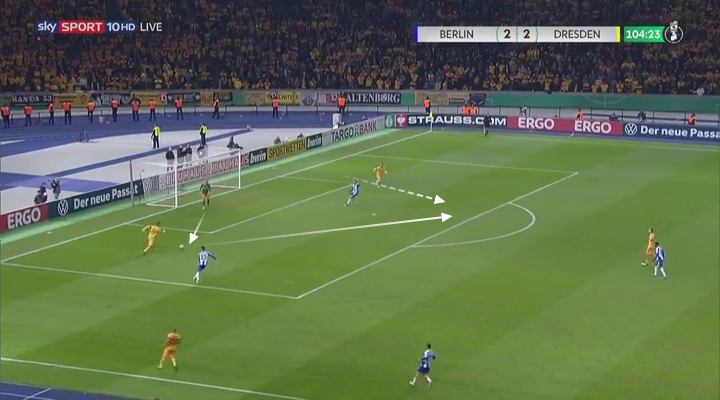
Execution and Rules During a Goal Kick
Techniques used by goalkeepers for an effective goal kick
A successful goal kick requires the goalkeeper to exhibit exceptional skill and technique. One of the most common techniques employed is the drop kick, where the goalkeeper drops the ball from their hands and strikes it just before it hits the ground.
This method allows for increased power and distance while maintaining accuracy. Another style often utilized is the side volley, where the goalkeeper strikes the ball mid-air with their side foot, providing greater control and precision.
Emphasizing proper technique and accuracy for successful distribution
The importance of proper technique during a goal kick cannot be overstated. Goalkeepers must focus on generating power through proper body positioning and weight transfer to achieve maximum distance.
Accuracy is equally vital; precise placement can initiate counter-attacks or launch an offensive move from deep in their own half. Maintaining composure amidst pressure from opposing players is also crucial, as this ensures effective distribution while minimizing potential turnovers.
Rules governing both attacking and defending players during a goal kick
Attacking players must adhere to specific regulations when contesting a goal kick. According to the Laws of the Game, they are prohibited from entering the penalty area until after the ball has left this designated zone during a goal kick.
This rule allows defenders an opportunity to clear danger without immediate threat or interruption. However, there are exceptions to this restriction.
If another player touches or plays the ball first after a goal kick, attacking players can legally challenge for possession inside the penalty area. In such cases, they no longer need to wait until after the ball exits this domain before engaging in active play.
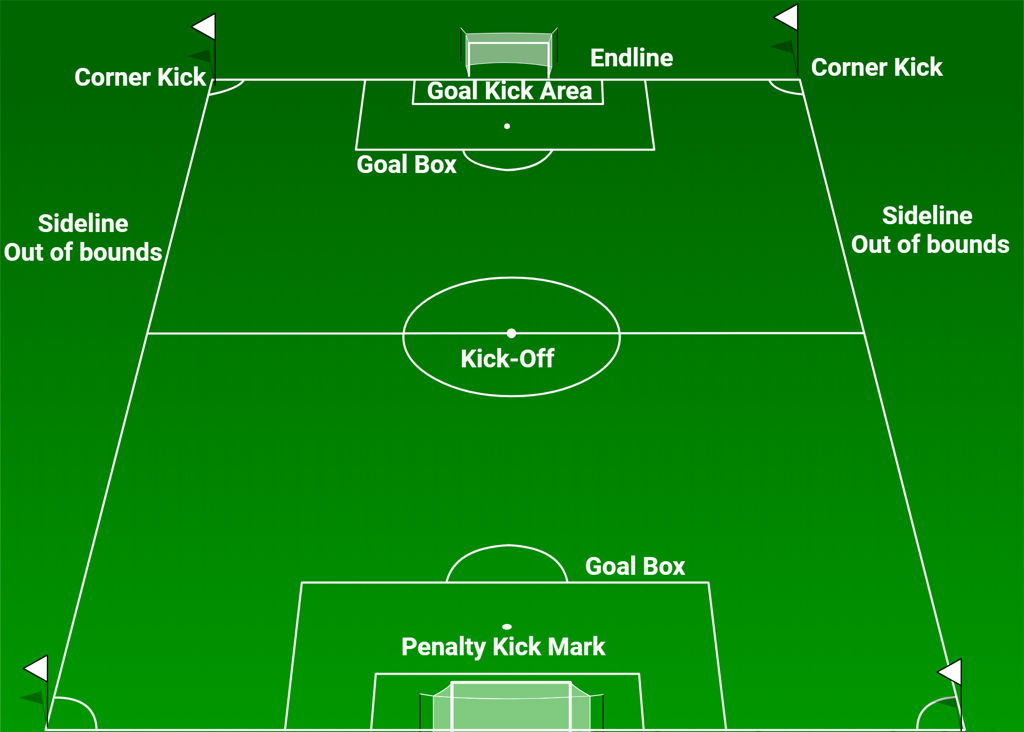
Common Misconceptions about Goal Kicks
Addressing common misunderstandings regarding offside during a goal kick
One common misconception surrounding goal kicks is the notion of offside. It is crucial to clarify that offside cannot be called during a goal kick.
The reason for this is straightforward: during a goal kick, all players except for the kicker are situated in their half of the field. Therefore, there can be no offside offenses committed by attacking players when the ball is in play directly from a goal kick.
It is essential to dispel this confusion as it often leads to contested decisions and debates among fans and even sometimes among players themselves. Understanding that offside cannot occur during a goal kick ensures fair play and prevents unnecessary controversy surrounding these restarts. (1)
Conclusion
Mastering the execution and rules of Law 16 – The Goal Kick requires not only technical prowess but also an understanding of its intricacies. Goalkeepers employ various techniques such as drop kicks or side volleys, focusing on proper technique and accuracy to ensure successful distribution.
Additionally, both attacking and defending players must adhere to specific regulations regarding entering the penalty area during a goal kick, with exceptions applying if another player touches or plays the ball first.
By clarifying common misunderstandings about offside during a goal kick, we promote fair play and enhance the enjoyment of the game. So let us take delight in witnessing expertly executed goal kicks, appreciating them as opportunities for strategic playmaking rather than being mired in misconceptions.
What is the best soccer position to play?
What is the best soccer position? Soccer is a sport that requires...
Read MoreSoccer Substitution Rules: The Strategic Art of Changing the Game
Soccer, known as the beautiful game worldwide, has seen various changes to...
Read MoreWhat is a Soccer Assist?
The Importance of Teamwork in Soccer The importance of teamwork in soccer...
Read MoreWhat is a clean sheet in soccer?
The Importance of Keeping a Clean Sheet: An Introduction to Soccer's Most...
Read MoreHow to Clean Soccer Cleats Like a Pro
The Importance of Cleaning Soccer Cleats Playing soccer is a great way...
Read MoreSoccer Position # 4 Center Back Explained
Center Back in soccer is the # 4 Position, also known as...
Read MoreCan Soccer Cleats Be Used For Baseball?… Pros and Cons…
Soccer and baseball are two different sports that require specific types of...
Read MoreAll About Soccer – Almost Everything You Need To Know
What Is Soccer? Soccer, also known as Association Football, is a popular...
Read MoreSoccer vs Football Field – A Tale of Two Fields
Comparing the Corners: Soccer Field Vs Football Field Shapes Let's talk a...
Read MoreMastering the Midfield Is The Key To Winning In Soccer
As soccer players try to gain control of the game, midfielders are...
Read MoreBest Laceless Soccer Cleats 2024
What Are The Best Laceless Soccer Cleats? Soccer players know the importance...
Read MoreBox-to-Box Center Midfielder: The Engine of Modern Soccer Teams
Soccer is a game of skill, strategy, and teamwork. Every player has...
Read Moresoccer position numbers quick guide
Each player on the field has an important job as it relates...
Read MoreWhat is a soccer tackle?
The Importance Of Mastering Tackling Skills For Success In Soccer To succeed...
Read MoreBest Grip Socks For Soccer 2025
In this post, we present the best grip socks for soccer, so...
Read MoreCan Indoor Soccer Shoes Be Used on Turf?
Introduction: Demystifying a Controversial Issue Soccer is a sport that requires specific...
Read MoreMastering Soccer Outside Back Position: Tips and Techniques
Soccer is a dynamic sport, and the outside back position is no...
Read MoreHow To Break In Soccer Cleats
How to break in soccer cleats The Importance of Breaking in Soccer...
Read MoreSoccer Tips: The Secret to Becoming a Better Player
Soccer is a sport that has become incredibly popular all around the...
Read MoreBest Soccer Backpacks 2024
Soccer demands that you carry gear, such as balls, cleats, uniforms, water...
Read MoreWhat is a Set Piece in Soccer?
What is a set piece in soccer? Introduction Soccer is a sport...
Read Moresoccer start and restart of play
Brief Overview: Soccer as a Popular Sport Worldwide Soccer's popularity stems from...
Read More9v9 Soccer Positions Explained
9v9 soccer, also known as small-sided soccer, is a variation of the...
Read MoreHow Many Soccer Games In A Season
The number of soccer games in a season varies depending on the...
Read MoreWhat is the hardest position in soccer to play?
What is The Hardest Position in Soccer Importance of understanding positions in...
Read MoreSoccer Corner Kick – Soccer Law #17
A corner kick is a type of free-kick that is awarded to...
Read MoreHow To Be A Good Soccer Parent! A Guide to Sideline Etiquette
What Makes A Good Soccer Parent? As a soccer parent, you have...
Read MoreHow Many Soccer Players Are On A Field?
The standard number of players on a soccer team is eleven. Each...
Read MoreThe Historical Dominance of Brazilian Soccer in the World Cup
Introduction: The Beautiful Game's Grandest Stage The World Cup, a grand tournament...
Read MoreBest Cheap Soccer Cleats 2024
What are the best soccer cleats? Soccer is a game that requires...
Read MoreThe Essential Soccer Skills Every Player Needs
From ball control to positioning, there are numerous technical aspects that every...
Read MoreThe Changing Role of Strikers in Soccer
The Changing Role of Strikers in Modern Soccer Soccer, known as the...
Read MoreWhat is a goal kick in soccer? Soccer Law #16
Soccer is governed by a set of rules known as the Laws...
Read MoreBreaking Down the False 9 Soccer Position
The false 9 position is a term used in soccer to describe...
Read MoreThe Transformation of German Soccer in the 2000s
Kickoff: A Brief Overview of German Soccer in the 2000s The Dawn...
Read MoreWhat is a cap in soccer?
If you're a soccer fan, you've probably heard the term "cap" being...
Read MoreBest Soccer Cleats For Wide Feet 2024
The world of soccer is vast, and players come in all shapes...
Read MoreThe Highest Scoring Games In Soccer History
Phew, after reading about the seven worst blowouts in soccer history, I...
Read MoreWhat is Soccer Relegation?
Introduction: Exploring the World of Soccer relegation Soccer is one of the...
Read More




















